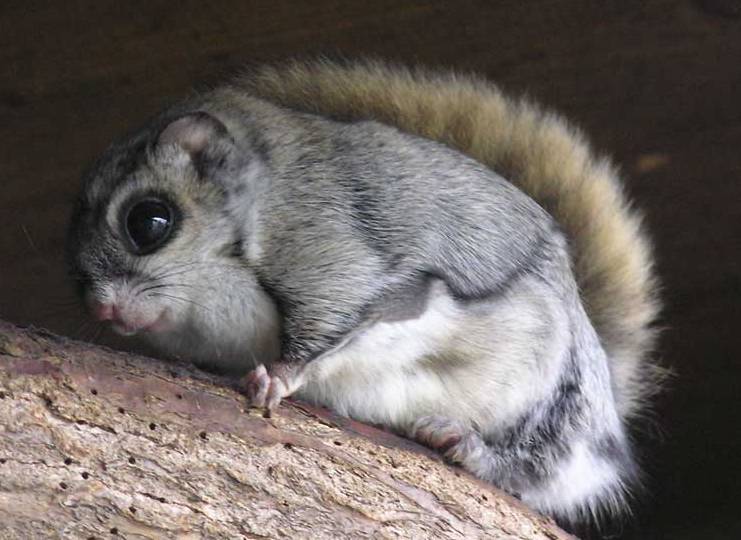
Siberian flying squirrel (Pteromys volans)
Phylum — chordata
Class — mammalia
Order — rodentia
Family — sciuridae
Genus – pteromys
Appearance
A female Siberian flying squirrel weighs about 150 grams, the males being slightly smaller on average. The body is 13–20 cm long, with a 9–14 cm long flattened tail.
The eyes are large and strikingly black. The coat is grey all over, the abdomen being slightly lighter than the back, with a black stripe between the neck and the forelimb. A distinctive feature of flying squirrels is the furry glide membrane or patagium, a flap of skin that stretches between the front and rear legs. By spreading this membrane the flying squirrel may glide from tree to tree across distances of over a hundred meters.
Habitat
Siberian flying squirrel occurs throughout Scandinavia, Russia, across northern Asia to Siberia and south along the Pacific coast of northern China.
Behavior
Pteromys volans are nocturnal. In the summer, they are active from a half hour to an hour after sunset until dawn. Most of this time is spent searching for food. During the winter, this period of activity is shorter and Siberian flying squirrels consume less food. When active, Siberian flying squirrels spend little time on the ground. They glide from tree to tree collecting and consuming food. During flight, they extend their forelimbs laterally, but their hind limbs are kept close together along the tail. This creates an unsual triangle silhouette.
Pteromys volans are a social species; many can be found together in a single tree. They build nests in vacant tree holes or in the junction of a branch and the trunk. Nests are often inhabited by pairs.
Diet
Its diet consists of leaves, seeds, cones, buds, sprouts, nuts, berries and occasionally bird eggs and nestlings. When alder and birch catkins are plentiful, the squirrel may store them for the winter in old woodpecker holes or similar nooks.
Reproduction
They mate early in the spring. After a gestation period of five weeks, the female gives birth to a litter of usually two or three young, each weighing about 5 grams. They preferentially build their nest in holes made by woodpeckers, but they may also nest in birdhouses if the size of the entrance is appropriate. The nest consists of a pile of soft materials (preferably soft beard lichen) into which the squirrel burrows.
They can live up to about five years.
In captivity
In a home zoo, the flying squirrel quickly learns, is not solicitous of food, is trusting people, and in many ways resembles a squirrel in behavior, but in contrast to it, it is perfectly tamed in a cage.
Keeping of flying squirrels is not difficult. The cage for flying squirrels is equipped in the same way as for ordinary squirrels, only it should be as spacious as possible. This animal feels even better in an open-air enclosure. It should have shaded places where the flying squirrel could hide from the scorching rays of the sun. The cage should also be placed so that it does not get the sun's rays in summer, and in winter — away from the сentral heating batteries. For this animal, dampness and drafts are also harmful. It is best to keep them in an enclosure of the "Mixed forest" type. When kept in closed enclosures, animals do not reproduce, as they need a significant seasonal temperature difference. It is better to move reproductive pairs to outdoor enclosures, where the animals will regularly bring offspring.
Feed the flying squirrels every day, placing the feed in the hanging feeders. There are separate feeders for juicy feeds and grains. The diet of flying squirrel consists of fresh fruits, dried fruits, pine and spruce seeds, milk powder, vitamin and mineral supplements, and milk is added to lactating females. Regularly put freshly cut branches, as this is the most important food for flying squirrels.
 Russian
Russian
 English
English























